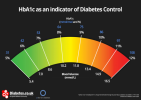Hi and welcome.
The important thing to be aware of is that Blood Glucose (BG) levels rise and fall throughout the day and night in response to many different factors. Food, exercise and medication are the 3 main factors. It sounds like you don't take diabetes medication but other meds like steroids can also affect it. There are approx. 42 factors including the 3 above but also stress, how much sleep you get, the ambient temperature, illness or pain, hormones, alcohol and even just the time of day which can increase or reduce those levels day in and day out. Any particular finger prick test is just a snap shot at that particular time.... whereas an HbA1c test (usually blood taken fro your arm and sent off to a lab) will give you a more general view of how your BG levels are being managed over a roughly 3 month period. The way in which HbA1c tests were reported as a % made it very easy to confuse them with finger prick tests because they were often both numbers below 10, whereas the current units of measuring HbA1c make it less confusing because the number will usually be in or above the region of 48. Unfortunately old habits die hard and many clinicians still report their HbA1c results in the old % system instead of the new mmols/mol. It is all a lot to get your head around I know but with more reading here on the forum it will become clearer. There is a chart which converts the old units to the new and makes it a bit easier to compare....
View attachment 21092
The BG levels on the bottom of the graph ie 5.4-16.5 are average BG levels so if you were testing a fingerprick multiple times day and night, the average of those readings would give you a rough idea of your HbA1c...... so say you were averaging a finger prick reading of 7.0 then your HbA1c would likely be about 42 or 6% in "old money".
BG will rise quite a bit after a meal even in a non-diabetic person and may occasionally go up to 10 and down to just below 4 and this can happen within a couple of hours, so there is quite a bit of fluctuation. I'm Type 1 and I wear a sensor which monitors my levels all the time and my goal is to try to keep it between 3.9 and 10 most of the time but I have insulin to use to try to achieve that because my body doesn't produce sufficient anymore. It is quite challenging trying to keep it in that range and the sensor produces a graph so that I can see just how my levels go up and down.
Understanding and accepting that levels go up and down a lot and what causes most of that in your body is the cornerstone of managing diabetes well in my opinion and that is why we encourage people to test their BG levels at home so that they can learn how their body responds, to food and exercise etc.
Having said that, it sounds like you are managing your diabetes pretty well at the moment, so maybe just continue what you are doing for now since it is working for you and if things change, then consider home testing as part of a more intensive strategy.

